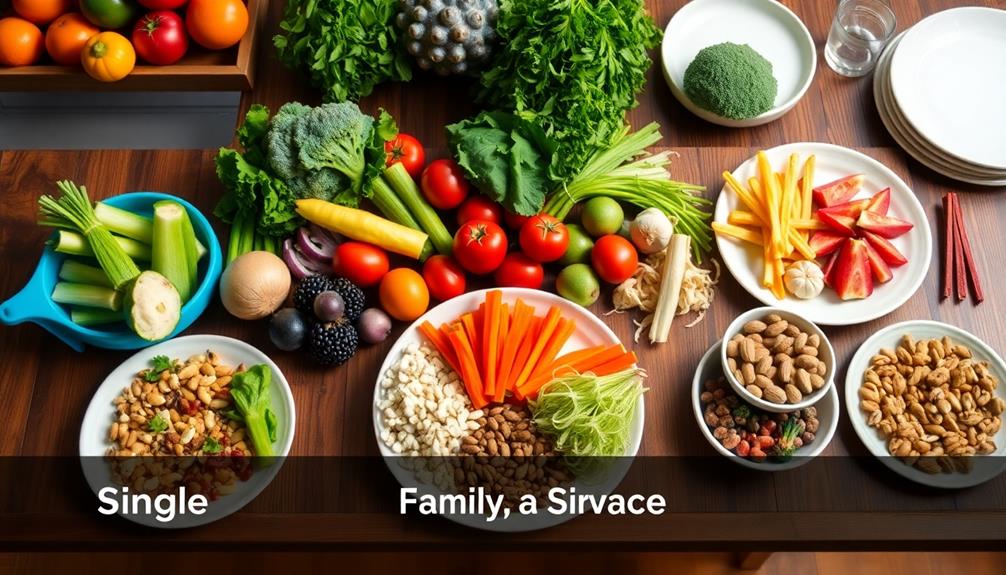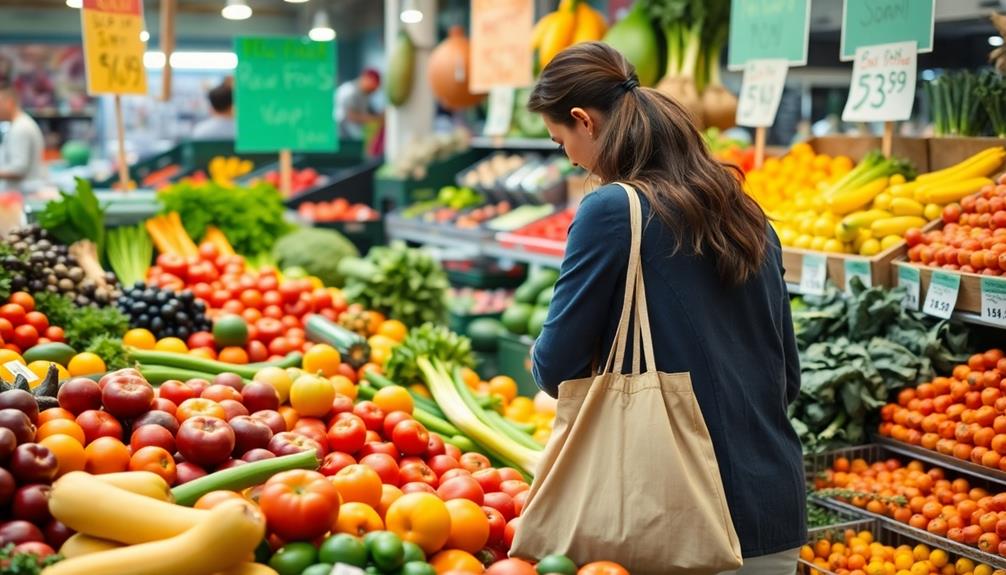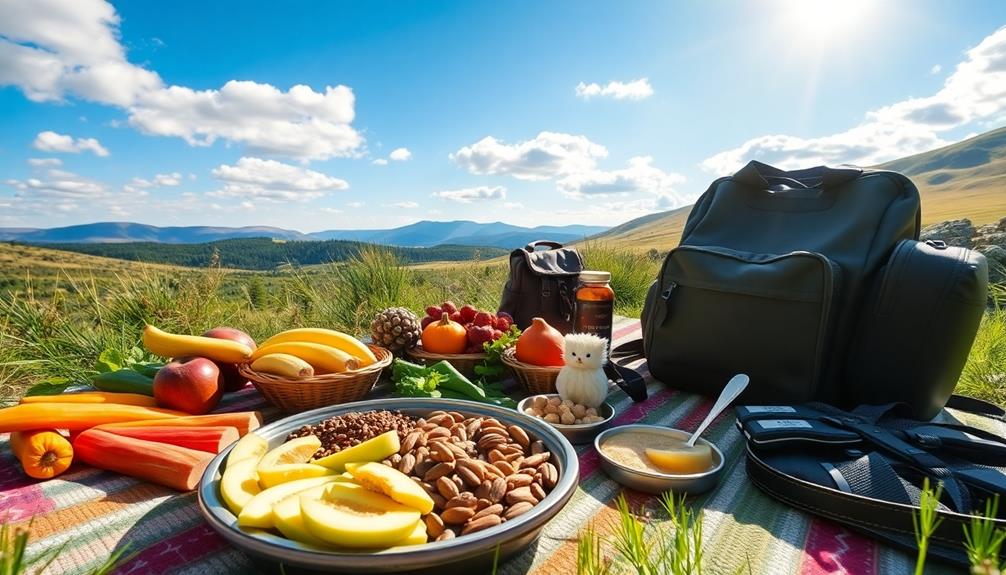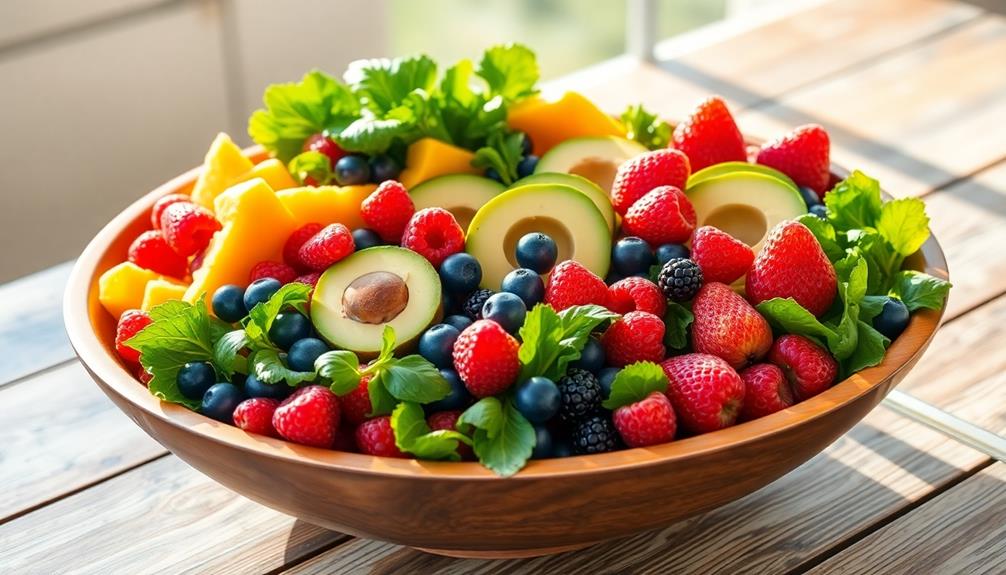When scaling raw food recipes from single servings to family portions, start by calculating the conversion factor. Divide the desired yield by the original yield to verify accuracy. Adjust ingredient ratios carefully; some flavors don't scale linearly. A digital kitchen scale helps with precise measurements, while storing leftovers in appropriate containers minimizes waste. Keep an eye on preparation techniques since larger quantities may need different handling. Finally, document your adjustments for consistency in future cooking. There's a lot more to evaluate, especially regarding flavor balance and cooking times, so keep exploring to master your scaling skills.
Key Takeaways
- Calculate the conversion factor by dividing the desired family portion yield by the original single portion yield for accurate scaling.
- Adjust ingredient ratios carefully, as some raw foods do not scale linearly, affecting flavor and texture.
- Use a digital kitchen scale for precise measurements and ensure consistent ingredient ratios throughout the scaling process.
- Pre-portion meals into appropriate storage containers to simplify meal prep and reduce food waste for family portions.
- Monitor freshness and adjust preparation techniques as necessary for larger quantities to maintain quality and taste.
Understanding Portion Control
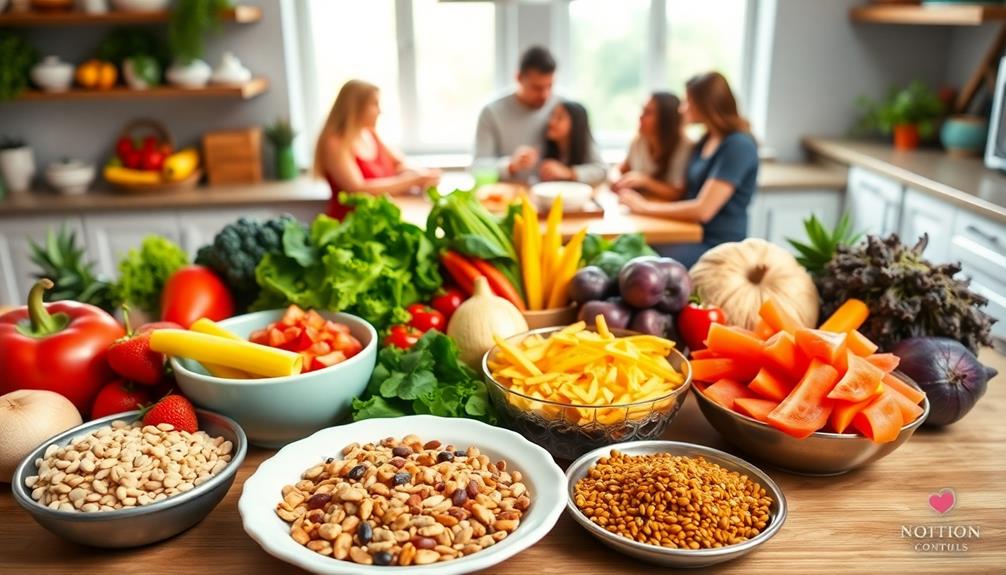
Understanding portion control is vital for anyone embracing a raw food diet. It helps you promote balanced nutrition, manage caloric intake, and prevent overeating, which can lead to digestive discomfort due to the high fiber content in raw foods.
Using a kitchen scale for precise measurements can greatly enhance your portion control. With accurate measurements, you can divide total recipe yields based on your desired serving sizes, ensuring consistent nutritional values across your meals.
Adjusting portion sizes according to your caloric needs and activity levels is also important. If you're engaging in rigorous exercise, you'll likely require larger portions compared to someone with a more sedentary lifestyle.
Pre-portioning your raw food meals into containers simplifies meal planning and reduces food waste. This practice encourages mindful eating by making it easier to stick to your portion goals throughout the week.
Scaling Recipes for Families
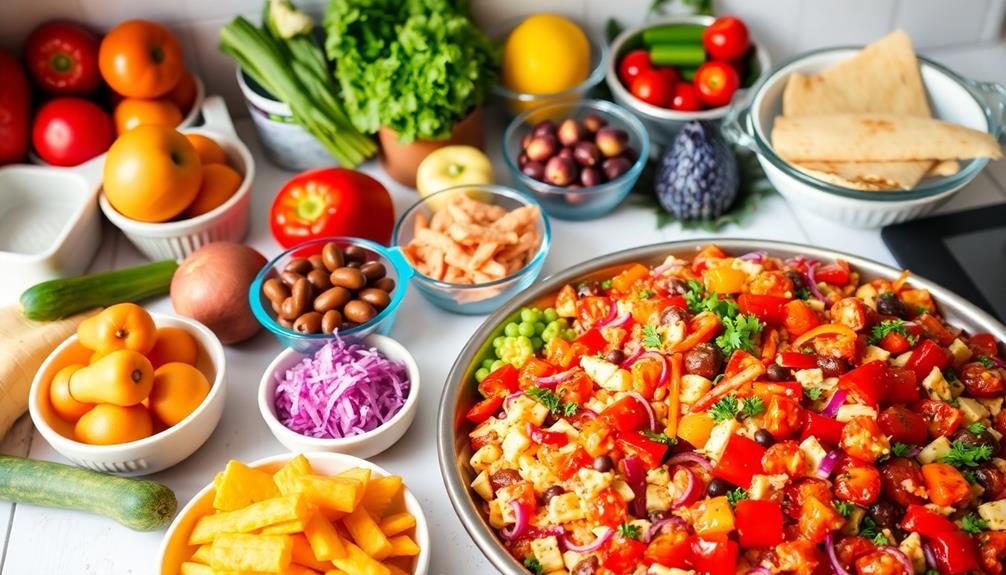
Scaling recipes for families can be a straightforward process when you know how to adjust your ingredients effectively. Start by calculating the conversion factor, which involves dividing the desired yield by the original yield. For instance, if you want to double a recipe that serves 4 to serve 8, simply multiply all ingredient weights by 2. This method helps guarantee that you're not just guessing amounts.
When preparing larger quantities, consider the importance of maintaining freshness, especially when using ingredients like aloe vera juice that offer numerous health benefits.
If you need to halve a recipe for a smaller gathering, do the reverse and divide the ingredient weights accordingly. Keep in mind that when scaling recipes for families, flavor adjustments are essential. Larger quantities might dilute the taste, so always taste and tweak as you go.
For larger groups, consider batch processing your raw ingredients. This helps maintain freshness and quality, as nutrients can diminish if prepared too far in advance.
Also, use appropriate storage containers to pre-portion any leftovers, giving you quick access to healthy meals while minimizing food waste. By following these steps, home cooks can easily adapt their favorite raw food recipes to fit family needs without compromising on flavor or quality.
Tools for Accurate Scaling
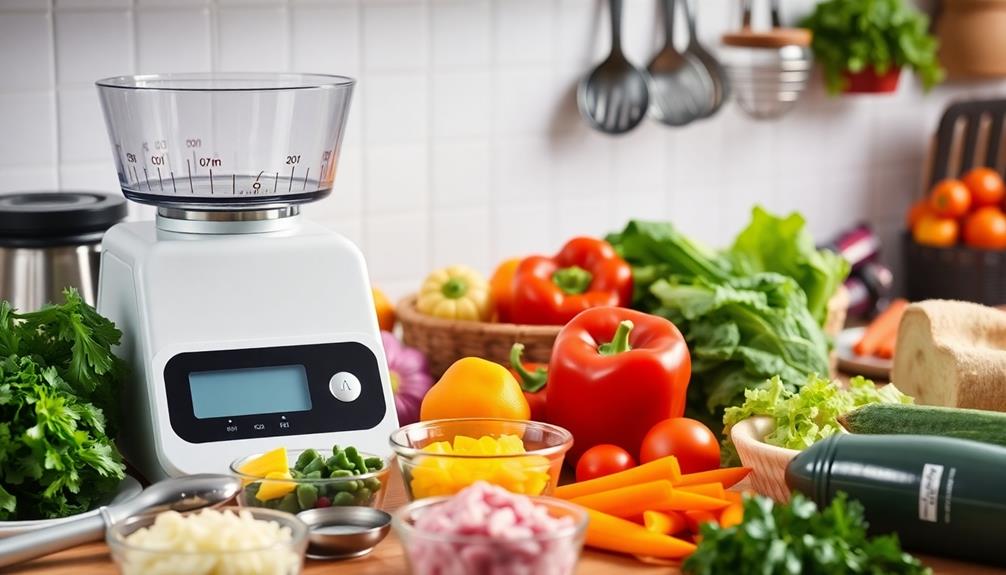
When it comes to accurately scaling your raw food recipes, having the right tools at your disposal makes all the difference. A digital kitchen scale is essential for precise measurements in grams, ensuring consistency in ingredient proportions. This tool allows you to scale down recipes while maintaining the integrity of flavors and textures.
In addition to a scale, using measuring cups and spoons will help you accurately measure liquid ingredients and smaller quantities. Portion control plates can visualize servings, making it easier to prepare balanced meals for your family.
To track your scaled adjustments, consider using recipe management apps. These apps simplify the process, allowing you to organize and modify your raw food recipes efficiently. Finally, keep conversion charts handy for volume-to-weight adjustments. This will help you accurately gauge ingredient proportions, especially for those that vary in density.
Here's a quick overview of essential tools:
| Tool | Purpose |
|---|---|
| Digital Kitchen Scale | Accurate measurements in grams |
| Measuring Cups/Spoons | For liquid ingredients and small amounts |
| Recipe Management Apps | Track and modify scaled adjustments |
Calculating Ingredient Adjustments
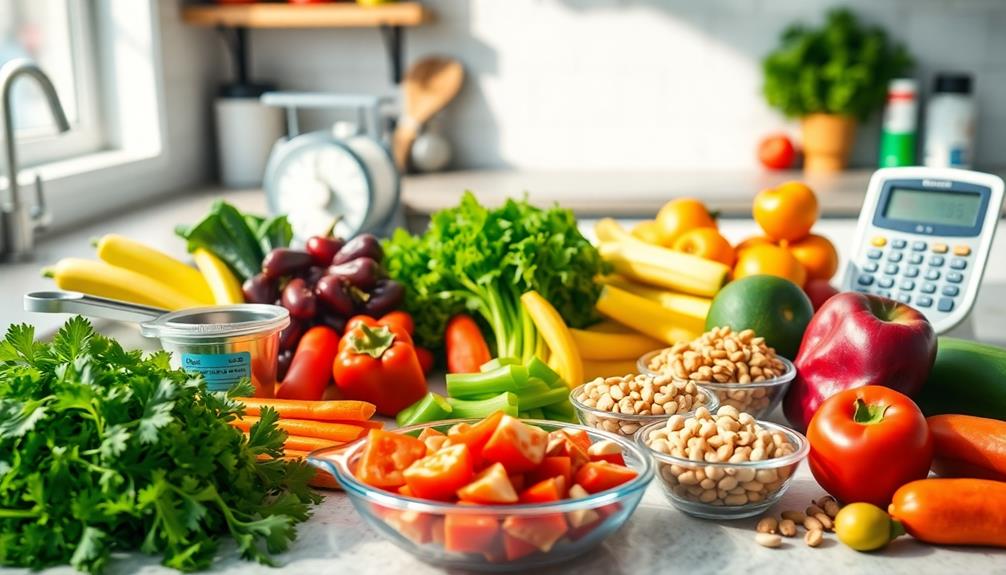
To calculate ingredient adjustments, you first need to determine the original yield of your recipe and the yield you want.
Once you've got those numbers, use the conversion factor formula to scale your ingredients accurately.
Ingredient Yield Determination
Determining ingredient yield is essential for achieving the perfect balance in your raw food recipes. To accurately scale your recipes, you'll need to identify both the original recipe yield and your desired yield. This way, you can calculate the conversion factor using the formula: (required yield) ÷ (recipe yield).
Follow these steps for precise ingredient adjustments:
- Identify the Original Yield: Know how many servings your recipe currently makes.
- Calculate the Conversion Factor: For example, if your recipe yields 4 servings and you need 10, your conversion factor is 2.5.
- Weigh Ingredients: Use a kitchen scale to measure your ingredients post-preparation. This is particularly important for fruits and vegetables, which can vary in size and water content.
Conversion Factor Calculation
Scaling a recipe accurately hinges on calculating the conversion factor. To find this factor, simply divide the desired yield by the original yield. For example, if you want to scale a recipe from 25 portions to 60 portions, your conversion factor would be 2.4. This means you need to multiply each ingredient amount by 2.4 to get the correct quantities.
Let's say your recipe calls for 3 cups of nuts. With a conversion factor of 2, you'd adjust this to 6 cups for the larger yield.
It's vital to keep your measurements consistent throughout the scaling process. Using weight instead of volume can enhance accuracy, especially for ingredients with varying densities.
Always double-check your calculations to avoid recipe failures, as even small errors can lead to big discrepancies in flavor and texture. Keeping a written record of your scaled ingredient amounts can help you stay organized and prevent mistakes during preparation.
With a clear understanding of the conversion factor, you'll confidently scale your favorite raw food recipes, ensuring they turn out deliciously every time, no matter the portion size!
Common Challenges in Scaling
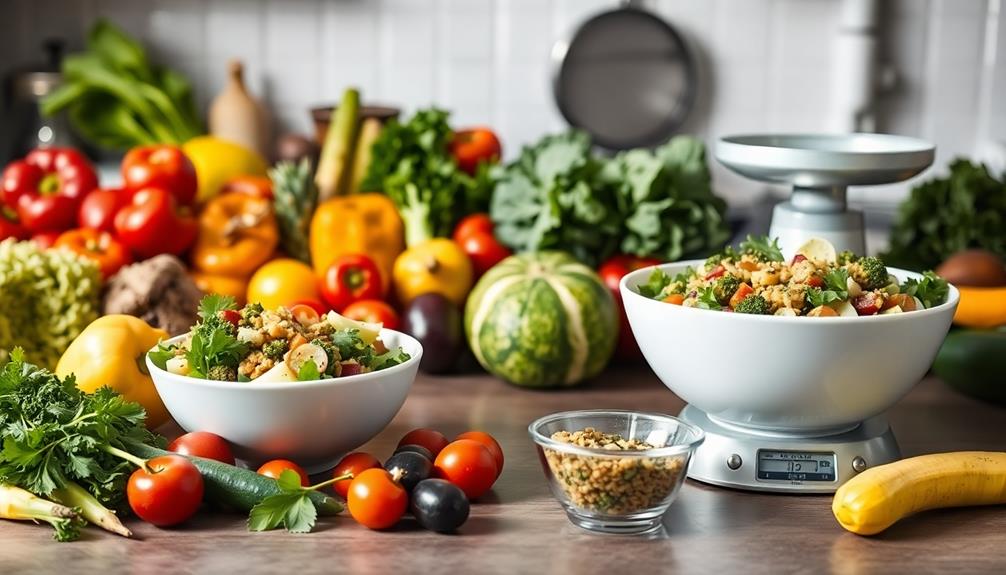
When you scale raw food recipes, you might encounter several challenges that can affect the final result. Maintaining the integrity of your dish can be tricky, especially when you're dealing with larger quantities. Here are some common challenges you may face:
- Flavor Balance: Some ingredients don't scale linearly, which can lead to an imbalance in taste and texture. You may need to adjust seasonings carefully.
- Ingredient Ratios: When increasing portion sizes, you must be precise with ingredient ratios, particularly for nuts or seeds, to avoid altering the dish's consistency.
- Nutritional Density: As you scale, the nutritional density of the dish can change. It's crucial to recalibrate nutrient distribution to guarantee that each serving remains balanced in macronutrients.
Additionally, larger quantities may require different preparation techniques, such as longer marination times or increased blending durations to achieve a uniform texture.
Storage and preservation also become more complex, so you'll need to verify proper conditions to maintain freshness and prevent spoilage.
Tips for Successful Scaling
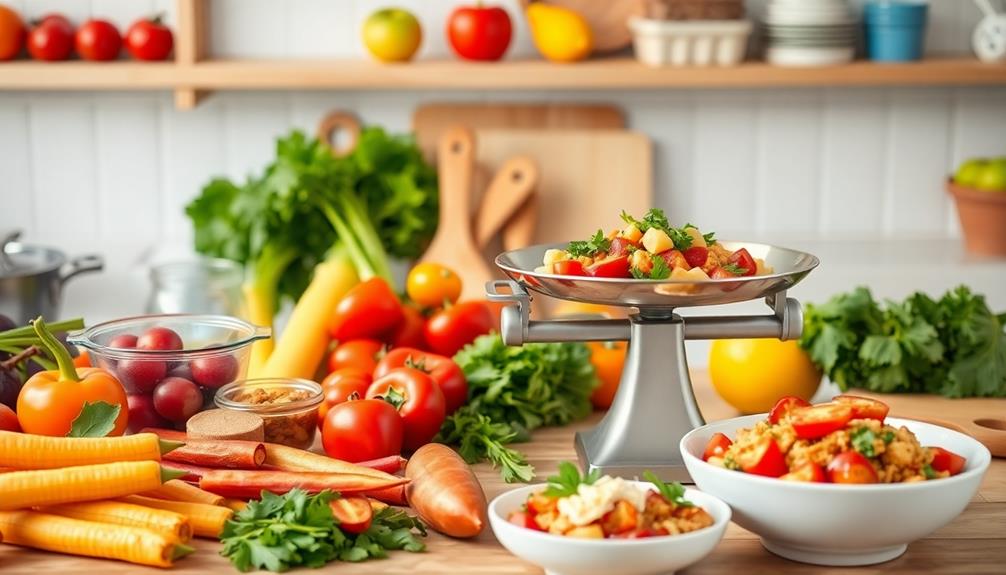
When you're scaling raw food recipes, adjusting ingredient ratios is vital for achieving the right flavor and texture.
For instance, when making raw nutrition bars, the balance of nuts and dried fruits is essential to maintain the desired consistency.
You'll also need to take into account baking time, as larger quantities may require more or less time in the process.
Make sure you use appropriate measuring tools and techniques to maintain accuracy throughout your scaling journey.
Adjusting Ingredient Ratios
Successfully adjusting ingredient ratios is vital for maintaining the desired flavor and texture of raw food recipes. When scaling up your original recipe, especially for small batch cooking, it's particularly important to keep proportions consistent.
Historically, similar principles applied to the production of ingredients like butter, where precise ratios were essential to achieving the desired quality and taste in culinary traditions butter's role in culinary traditions.
Here are some tips to help you achieve that:
- Use a Conversion Factor: Divide the desired yield by the original yield. Apply this factor to each ingredient to guarantee accurate scaling.
- Adjust Fats Carefully: Ingredients like oils or nut butters can change flavor intensity when scaled. Start with a lower amount and adjust to taste as needed.
- Mind the Herbs and Spices: Begin with half the original amount. Since their potency can vary, you can gradually increase to achieve the right flavor.
Always document any adjustments you make. This practice guarantees consistency for future batches, especially when you're experimenting with different ingredient ratios.
Baking Time Considerations
Scaling up your raw food recipes can throw a wrench into your baking times, so it's essential to keep a close eye on the clock. When you increase the quantity, start by reducing the baking times by 10-15 minutes from what the original recipe suggests. This is especially important for larger cakes, which may require longer to cook through.
Always perform the toothpick test to check for doneness.
Cookies, on the other hand, generally maintain their original baking times, regardless of how many batches you decide to make two. If you switch pan sizes, like from metal to glass, adjust your oven temperature by 25°F to guarantee ideal results.
For significant scaling—more than three times the original recipe—be prepared for unexpected changes in texture and flavor. It's wise to test with a smaller batch first.
Measuring Tools and Techniques
Achieving consistent results in scaling raw food recipes hinges on having the right measuring tools and techniques at your disposal. To guarantee accurate measurement, consider the following essentials:
- Digital Kitchen Scale: This is your best friend for precise ingredient measurement by weight, offering consistency regardless of portion sizes.
- Measuring Cups and Spoons: Use dry and liquid measuring cups, along with measuring spoons, to help you get exact amounts needed when scaling recipes.
- Pre-Portioning Containers: These simplify meal prep and minimize food waste, making it easy to prepare only what you need.
When scaling recipes, remember to calculate a conversion factor by dividing your desired yield by the original yield.
Also, be cautious with ingredient ratios; some raw foods don't scale linearly, affecting your dish's flavor and texture.
By employing the right measuring tools and techniques, you can achieve accurate measurements and maintain the integrity of your raw food recipes, no matter the serving size.
This way, you'll enjoy delicious results every time!
Frequently Asked Questions
What Is the Formula for Scaling a Recipe?
To scale a recipe, calculate the conversion factor by dividing the desired yield by the original yield. Multiply each ingredient's amount by this factor to adjust the quantities accurately for your needs.
What Are the Steps for Scaling a Recipe When the Portion Size Is Changed?
To scale a recipe, first determine the original and required yields. Calculate the conversion factor, adjust ingredient amounts accordingly, and use weight measurements for accuracy. Document changes to guarantee consistent results in future preparations.
How to Calculate Serving Size in Homemade Food?
Imagine a baker crafting loaves of bread. To calculate serving size, weigh the final loaf, then divide by the number of slices you want. Adjust for personal preferences, ensuring everyone enjoys their share.
How Do I Downsize a Recipe?
To downsize a recipe, determine the original and desired yields, calculate the conversion factor, and multiply each ingredient by that factor. Test the new amounts to guarantee flavors and textures stay balanced.
Conclusion
Scaling recipes from single servings to family portions is like tending to a garden; each ingredient is a seed that needs the right amount of space to flourish. By mastering portion control and being mindful of adjustments, you can cultivate meals that nourish everyone. Embrace the tools and tips shared, and watch your culinary creations bloom into hearty feasts. With a little practice, you'll transform your kitchen into a vibrant hub of shared love and deliciousness.

